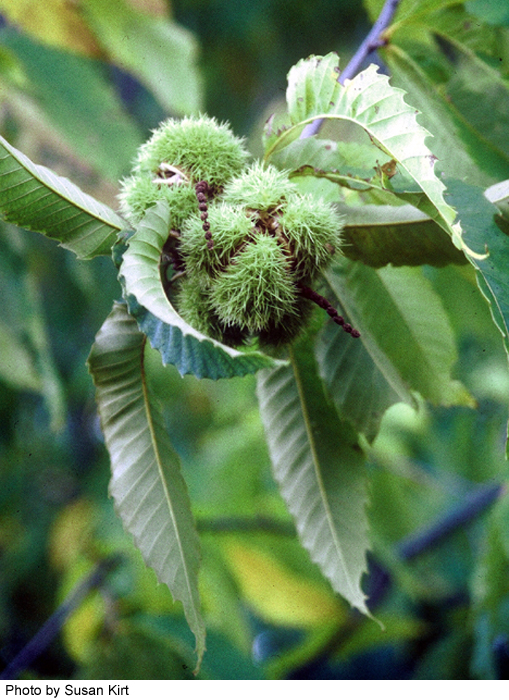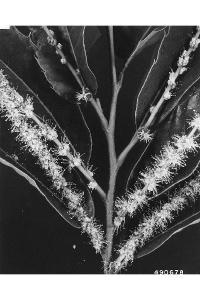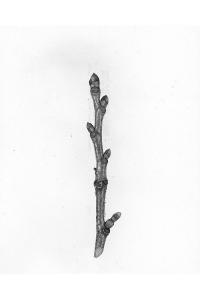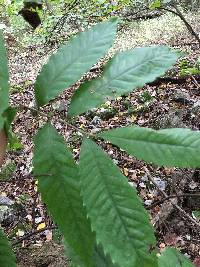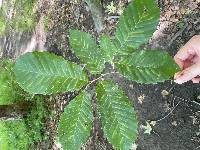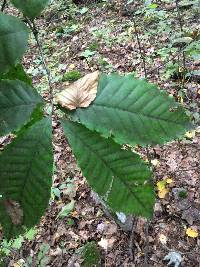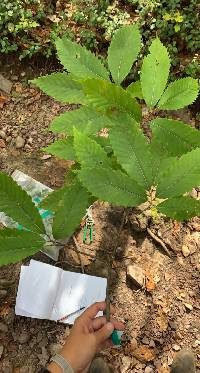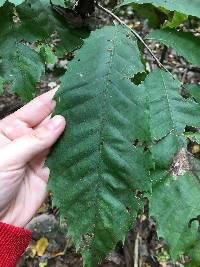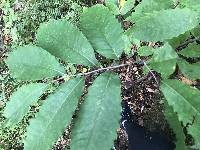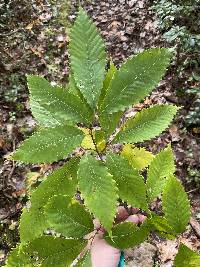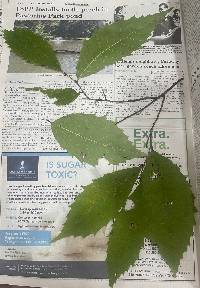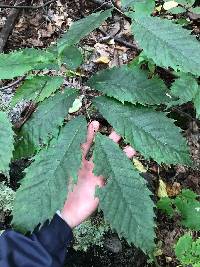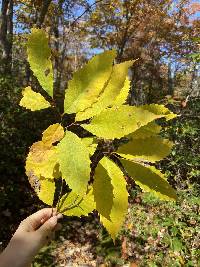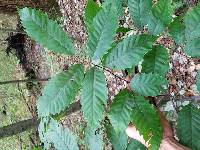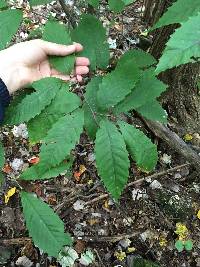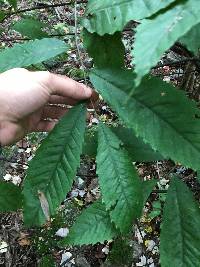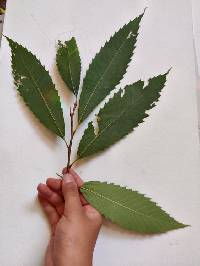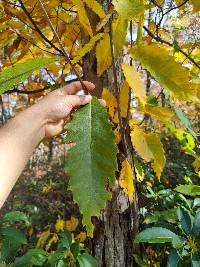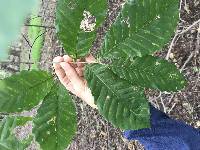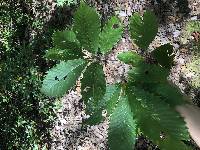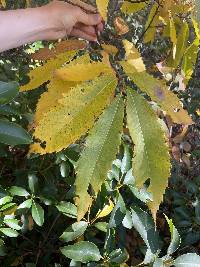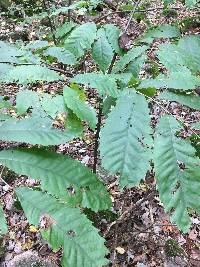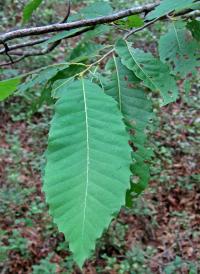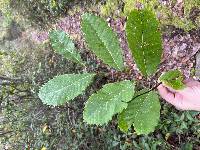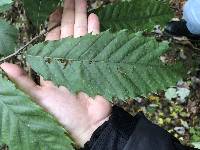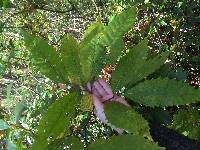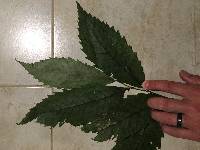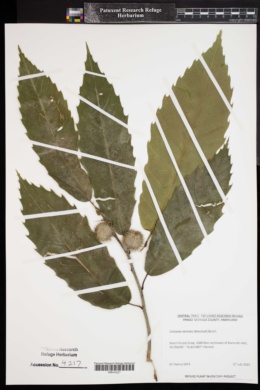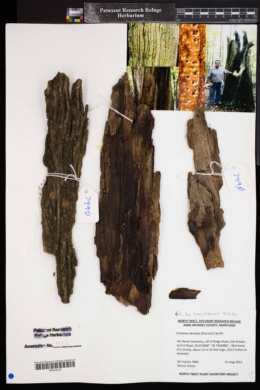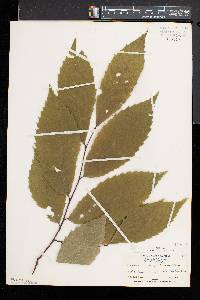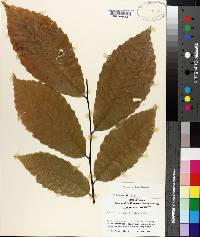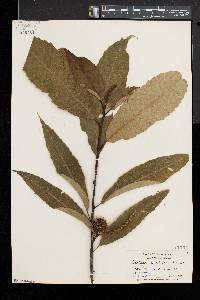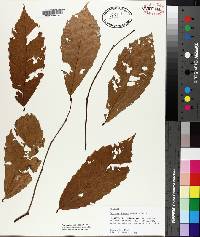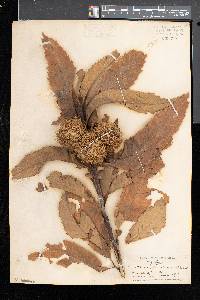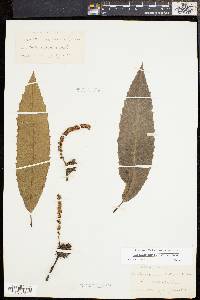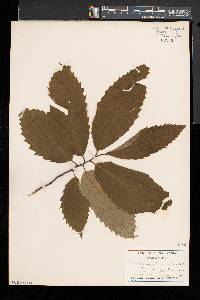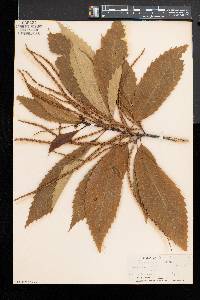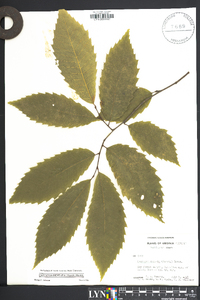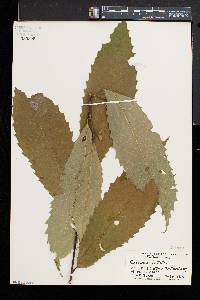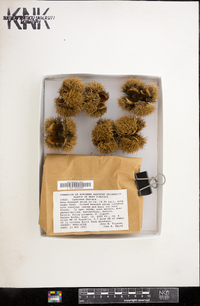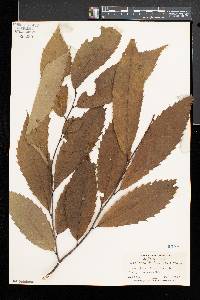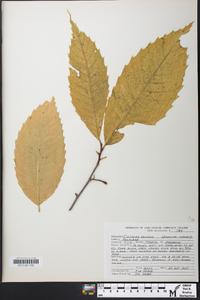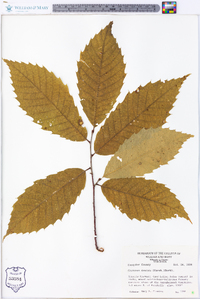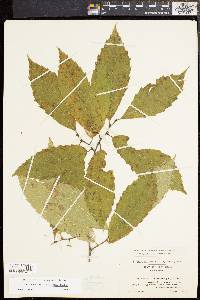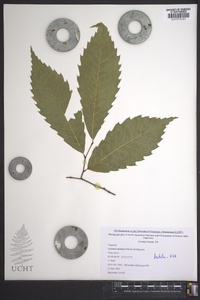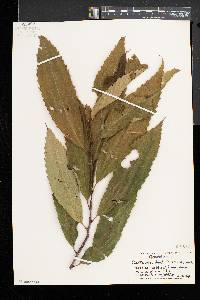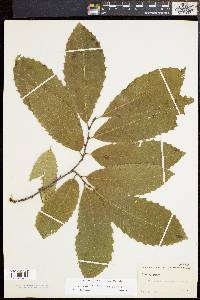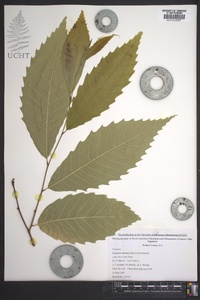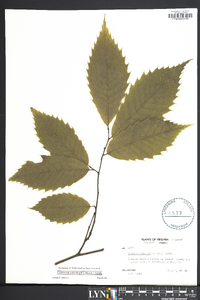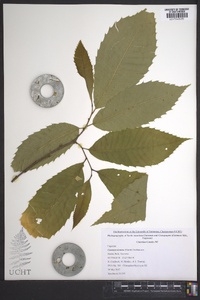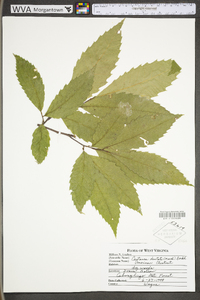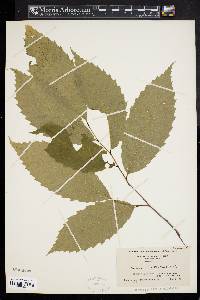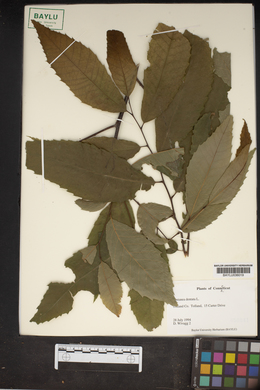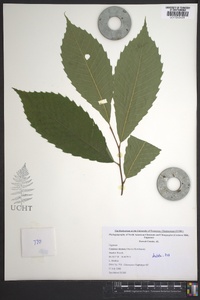
|
|
|
|
Family: Fagaceae
American Chestnut
[Castanea americana (Michx.) Raf., moreCastanea sativa var. americana , Castanea vulgaris var. americana] |
Trees , often massive, formerly to 30 m, now persisting mostly as multistemmed resprouts to 5-10 m because of widespread destruction by blight. Bark gray, smooth when young, furrowed in age. Twigs glabrous. Leaves: petiole (8-)10-30(-40) mm. Leaf blade narrowly obovate to oblanceolate, 90-300 × 30-100 mm, base cuneate, margins sharply serrate, each tooth triangular, gradually tapering to awn often more than 2 mm, apex acute or acuminate, surfaces abaxially often without stellate trichomes, appearing glabrous but with evenly distributed, minute, multicellular, embedded glands between veins and sparse, straight, simple trichomes concentrated on veins, stellate or tufted trichomes absent. Staminate flowers with conspicuous pistillodes, whitish or yellowish straight hairs in center of flower. Pistillate flowers 3 per cupule. Fruits: cupule 4-valved, enclosing 3 flowers/fruits, valves irregularly dehiscing along 4 sutures at maturity, spines of cupule essentially glabrous, with a few scattered simple trichomes; nuts 3 per cupule, obovate, 18-25 × 18-25 mm, flattened on 1 or both sides, beak to 8mm excluding styles. Flowering summer (Jun-Jul). Previously common in rich deciduous and mixed forests, particularly with oak; 0-1200 m; Ont.; Ala., Conn., Del., Fla., Ga., Ill., Ind., Ky., La., Maine, Md., Mass., Mich., Miss., Mo., N.H., N.J., N.Y., N.C., Ohio, Pa., R.I., S.C., Tenn., Vt., Va., W.Va., Wis. The American chestnut was one of the most important dominant forest trees of eastern North America prior to 1930. The nuts, sweet and edible, were a favorite confection in the eastern United States. The wood is light, strong, and resistant to decay; it was widely used for construction, furniture, and decorative trim. The bark was used for tanning leather. Native Americans used various parts of the plants of Castanea dentata medicinally as a cough syrup and to treat whooping cough, for heart trouble, and as a powder for chafed skin (D. E. Moerman 1986). After 1930, most populations of Castanea dentata were nearly destroyed by the chestnut blight, caused by the introduced fungus Cryphonectria parasitica (Murrill) M. E. Barr [= Endothia parasitica (Murrill) P. J. Anderson & H. W. Anderson]. While chestnuts persist in many localities, the plants are mostly resprouts that rarely, if ever, produce viable seed. Virtually all known natural populations remain infected with the blight, and various studies continue in an effort to find ways to improve growth and vitality of infected trees. The species was widely planted outside of its native range (e.g., Illinois, Indiana, Iowa, Michigan, and Wisconsin), and some of these plantings remain blight-free because of their isolation. One particularly large grove was planted near West Salem, Wisconsin, in 1880, and continuing regeneration through seedlings has been documented (F. L. Paillet and P. A. Rutter 1989). Unfortunately, chestnut blight has recently been discovered in this isolated population and probably is extending to other isolated plantings in the west. As part of the effort to introduce blight-resistant strains of the American chestnut, breeding programs have produced hybrids of Castanea dentata in various combinations with exotic species of chestnut. These hybrids are often extremely difficult to identify because they may derive from as many as three parents in complicated backcrosses. When identifying trees suspected of being introduced, one should be aware of the three most commonly cultivated exotic chestnut species, all of which have been collected as sporadic escapes or persistent waifs: Castanea sativa Miller - Spanish chestnut Leaf blade abaxially with sparse to dense covering of stellate hairs, also with conspicuous glands as in C . dentata . Petiole relatively long (30 mm or more). Castanea mollissima Blume - Chinese chestnut Twigs with spreading hairs. Leaf blade abaxially cobwebby-pubescent, without conspicuous foliar glands found in Castanea dentata . Resistant to blight and widely cultivated in the United States, where it occasionally escapes. Castanea crenata Siebold & Zuccarini - Japanese chestnut Leaf blade abaxially with minute, glandular, peltate scales mixed with dense, tangled tomentum. Vegetatively, this species may be di Tree historically 18 - 25 m tall with a 0.5 - 1 m diameter trunk, but typically less than 10 m tall today Leaves: alternate, short-stalked, yellowish green above, paler beneath, 15 - 28 cm long, 4 - 8 cm wide, oblong to lance-shaped with a pointed tip, sharply toothed with vein extending into a bristle on each tooth, hairy when emerging, becoming smooth. Flowers: either male or female, found on the same tree (monoecious), borne on upright catkins with female flowers usually near the base, yellowish green, fragrant. Fruit: a very sharp spiny bur, 4.8 - 7.5 cm in diameter, splitting along four sides to expose one to three brown, partially flattened, edible nuts. Bark: smooth and gray when young, becoming dark brown and developing shallow fissures or furrows and flat, broad ridges. Twigs: angled at nodes, yellowish green and slightly hairy, becoming olive green to dark brown and smooth with age. Buds: dark brown, egg-shaped, 6 mm long. Terminal buds usually absent. Similar species: Castanea dentata, Quercus muhlenbergii and Quercus montana have similar leaves. The teeth of Q. muhlenbergii leaves are somewhat sharply pointed but do not have extended bristles, while the teeth of Q. montana leaves are somewhat rounded. Additionally, Q. montana has a shiny acorn, the twigs are orangish brown, and the bark is nearly black and fissured to furrowed. Quercus muhlenbergii has acorns with slightly hairy cups covering one-quarter to half of the nut and silvery gray, thin, flaking bark with narrow scales. Flowering: June Habitat and ecology: Castanea dentata was introduced into the Chicago Region from the eastern United States. It used to be found in well-drained rocky woods, dry-mesic areas, and oak-hickory forests. Today, trees sprout from the base of former trees, but are usually killed by chestnut blight before they reach a reproductive age. Occurence in the Chicago region: non-native Notes: Once a dominant tree in oak forests of the eastern United States and valued for its timber and nut production, C. dentata has been virtually destroyed by the chestnut blight fungus. Chestnut blight is believed to have come to America on C. mollissima, Chinese chestnut. The blight was found in New York in 1904 and rapidly spread across the United States. Attempts were made to prevent spread of the disease, but fungal spores traveled long distances by wind. Today, most C. dentata are short-lived sprouts from former trees or are in isolated areas that have not yet been infected by the chestnut blight fungus. Etymology: Castanea is the Latin name for chestnut, derived from Castania, a town in Thessaly, which was known for its chestnuts. Dentata comes from the Latin word for toothed. Author: The Morton Arboretum Tree to 30 m; lvs oblong-lanceolate, acuminate, coarsely and sharply serrate with ascending or incurved teeth, glabrous or nearly so, short-petioled; staminate catkins to 20 cm; mature involucres 5-6 mm thick, with very numerous spines 1 cm or more, the nuts 1.5-2 cm, usually 2 or 3 together, flattened on one or two sides; 2n=24. Original range from s. Me. to se. Mich., s. to Del., Ky., and s. Ill., and along the mts. to Ala., usually in acid upland soils; now nearly exterminated by blight. Gleason, Henry A. & Cronquist, Arthur J. 1991. Manual of vascular plants of northeastern United States and adjacent Canada. lxxv + 910 pp. ©The New York Botanical Garden. All rights reserved. Used by permission. From Flora of Indiana (1940) by Charles C. Deam The chestnut is restricted to the part of the state indicated on the map. It is found usually on sandstone outcrops and is usually local. In 1936 it was reported from Ripley County by Dorothy Parker. On account of its excellent qualities for shingles, posts, and poles, the large trees have all been cut. It is especially valuable for its timber and nuts, but its use as a forest tree will be curtailed because the chestnut blight has already appeared in a few places in Indiana. ...... Often called water beech. Frequent to common throughout the state in moist woodland. It prefers a moist, rich soil but has a range of habitats in the state from the tamarack bog to the dry, black and white oak slope. It is tolerant of shade. Having no commercial value, it is regarded by foresters as a weed tree. ...... Indiana Coefficient of Conservatism: C = 10 Wetland Indicator Status: UPL Deam (1932): In the Ind. Geol Rept. 1874:70. 1875 there is a reference to a "stump in Jackson County that was 9 ft. and 2 in. in diameter." This species is rather gregarious in habit, and rarely are isolated trees found. It is quite local in its distribution, but where found it is usually a common tree. The bark was much used in tanning, and the timber for poles, ties, and posts. The demand for this species has led to heavy cutting, so that the present supply is practically limited to inferior or small trees. The nut crop in this state is usually badly infested by the weevil. This species is easily propagated by seed or seedlings. It is recommended for forest planting in all parts of its natural range and in other parts of the state where the soil is very sandy and free from limestone. This species never attains an old age when growing close to limestone. It grows rapidl and requires little pruning. The only objection to planting it for forestry purposes is that it might be attacked by the chestnut bark disease which is fatal to it. This disease is far to the east of us, and there are wide barriers to its western migration. Since a chestnut grove would soon grow into post and pole size, in the event the grove would be killed by the bark disease, the crop could be harvested and the loss would be more of the nature of a disappointment than a financial one. If planted in a cleared area the seedlings should be spaced 6 x 6 feet if no cultivation can be done. If the trees can be cultivated plant 8 x 8 feet and grow corn for one or two years between the rows. |
|
|
|

